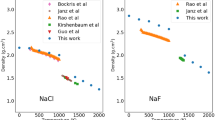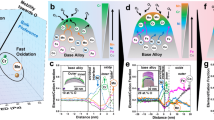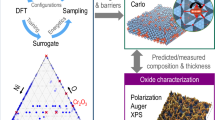Abstract
The presence of water vapour, intentional or unavoidable, is crucial to many materials applications, such as in steam generators, turbine engines, fuel cells, catalysts and corrosion1,2,3,4. Phenomenologically, water vapour has been noted to accelerate oxidation of metals and alloys5,6. However, the atomistic mechanisms behind such oxidation remain elusive. Through direct in situ atomic-scale transmission electron microscopy observations and density functional theory calculations, we reveal that water-vapour-enhanced oxidation of a nickel–chromium alloy is associated with proton-dissolution-promoted formation, migration, and clustering of both cation and anion vacancies. Protons derived from water dissociation can occupy interstitial positions in the oxide lattice, consequently lowering vacancy formation energy and decreasing the diffusion barrier of both cations and anions, which leads to enhanced oxidation in moist environments at elevated temperatures. This work provides insights into water-vapour-enhanced alloy oxidation and has significant implications in other material and chemical processes involving water vapour, such as corrosion, heterogeneous catalysis and ionic conduction.
This is a preview of subscription content, access via your institution
Access options
Access Nature and 54 other Nature Portfolio journals
Get Nature+, our best-value online-access subscription
$32.99 / 30 days
cancel any time
Subscribe to this journal
Receive 12 print issues and online access
$259.00 per year
only $21.58 per issue
Buy this article
- Purchase on SpringerLink
- Instant access to full article PDF
Prices may be subject to local taxes which are calculated during checkout




Similar content being viewed by others
References
Steele, B. C. H. & Heinzel, A. Materials for fuel-cell technologies. Nature 414, 345–352 (2001).
Eliaz, N., Shemesh, G. & Latanision, R. M. Hot corrosion in gas turbine components. Eng. Fail. Anal. 9, 31–43 (2002).
Dutta, R. S. Corrosion aspects of Ni–Cr–Fe based and Ni–Cu based steam generator tube materials. J. Nucl. Mater. 393, 343–349 (2009).
Zope, B. N., Hibbitts, D. D., Neurock, M. & Davis, R. J. Reactivity of the gold/water interface during selective oxidation catalysis. Science 330, 74–78 (2010).
Douglass, D. L., Kofstad, P., Rahmel, P. & Wood, G. C. International workshop on high-temperature corrosion. Oxid. Met. 45, 529–620 (1996).
Saunders, S. R. J., Monteiro, M. & Rizzo, F. The oxidation behaviour of metals and alloys at high temperatures in atmospheres containing water vapour: a review. Prog. Mater. Sci. 53, 775–837 (2008).
Hultquist, G., Tveten, B. & Hörnlund, E. Hydrogen in chromium: influence on the high-temperature oxidation kinetics in H2O, oxide-growth mechanisms, and scale adherence. Oxid. Met. 54, 1–10 (2000).
Henry, S., Mougin, J., Wouters, Y., Petit, J. P. & Galerie, A. Characterization of chromia scales grown on pure chromium in different oxidizing atmospheres. Mater. High. Temper. 17, 231–234 (2000).
Michalik, M., Hänsel, M., Zurek, J., Singheiser, L. & Quadakkers, W. J. Effect of water vapour on growth and adherence of chromia scales formed on Cr in high and low pO2-environments at 1000 and 1050 °C. Mater. High. Temper. 22, 213–221 (2005).
Essuman, E. et al. Enhanced internal oxidation as trigger for breakaway oxidation of Fe–Cr alloys in gases containing water vapour. Scri. Mater. 57, 845–848 (2007).
Zurek, J. et al. Growth and adherence of chromia based surface scales on Ni-base alloys in high- and low-pO2 gases. Mater. Sci. Eng. A 477, 259–270 (2008).
Zhou, G. et al. Step-edge-induced oxide growth during the oxidation of Cu surfaces. Phys. Rev. Lett. 109, 235502 (2012).
Li, L. et al. Surface-step-induced oscillatory oxide growth. Phys. Rev. Lett. 113, 136104 (2014).
LaGrow, A. P., Ward, M. R., Lloyd, D. C., Gai, P. L. & Boyes, E. Visualizing the Cu/Cu2O interface transition in nanoparticles with environmental scanning transmission electron microscopy. J. Am. Chem. Soc. 139, 179–185 (2017).
Fujita, T. et al. Atomic origins of the high catalytic activity of nanoporous gold. Nat. Mater. 11, 775–780 (2012).
Yoshida, H. et al. Visualizing gas molecules interacting with supported nanoparticulate catalysts at reaction conditions. Science 335, 317–319 (2012).
Gai, P. L. et al. Visualisation of single atom dynamics in water gas shift reaction for hydrogen generation. Catal. Sci. Tech. 6, 2214–2227 (2016).
Zhang, X. et al. Direction-specific van der Waals attraction between rutile TiO2 nanocrystals. Science 356, 434–437 (2017).
Luo, L. et al. In situ atomic scale visualization of surface kinetics driven dynamics of oxide growth on a Ni-Cr surface. Chem. Commun. 52, 3300–3303 (2016).
Henderson, M. A. The interaction of water with solid surfaces: fundamental aspects revisited. Surf. Sci. Rep. 46, 1–308 (2002).
Norby, T. Protonic defects in oxides and their possible role in high temperature oxidation. J. Phys. IV Fr. 03, C9-99–C99-106 (1993).
AtkinsonA. The Role of Active Elements in the Oxidation Behaviour of High Temperature Metals and Alloys: Effect of Active Elements on Diffusion Properties of Synthetic Oxides, 55. (Elsevier Science Publishing, New York, NY, 1989).
Gai, P. L. et al. Atomic-resolution environmental transmission electron microscopy for probing gas–solid reactions in heterogeneous catalysis. MRS Bull. 32, 1044–1050 (2007).
Gai, P. L., Lari, L., Ward, M. R. & Boyes, E. D. Visualisation of single atom dynamics and their role in nanocatalysts under controlled reaction environments. Chem. Phys. Lett. 592, 355–359 (2014).
Gómez-Rodríguez, A., Beltrán-del-Río, L. M. & Herrera-Becerra, R. SimulaTEM: multislice simulations for general objects. Ultramicroscopy 110, 95–104 (2010).
Kresse, G. & Furthmüller, J. Efficient iterative schemes for ab initio total-energy calculations using a plane-wave basis set. Phys. Rev. B 54, 11169–11186 (1996).
Kresse, G. & Hafner, J. Ab initio molecular dynamics for liquid metals. Phys. Rev. B 47, 558–561 (1993).
Dudarev, S. L., Botton, G. A., Savrasov, S. Y., Humphreys, C. J. & Sutton, A. P. Electron-energy-loss spectra and the structural stability of nickel oxide: an LSDA+ U study. Phys. Rev. B 57, 1505–1509 (1998).
Yu, J., Rosso, K. M. & Bruemmer, S. M. Charge and ion transport in NiO and aspects of Ni oxidation from first principles. J. Phys. Chem. C 116, 1948–1954 (2012).
Henkelman, G., Uberuaga, B. P. & Jónsson, H. A climbing image nudged elastic band method for finding saddle points and minimum energy paths. J. Chem. Phys. 113, 9901–9904 (2000).
Acknowledgements
This work was supported by the US Department of Energy (DOE), Office of Science, Basic Energy Sciences, Materials Sciences and Engineering Division. The work was conducted in the William R. Wiley Environmental Molecular Sciences Laboratory (EMSL), a DOE User Facility operated by Battelle for the DOE Office of Biological and Environmental Research. Pacific Northwest National Laboratory is operated for the DOE under contract DE-AC05-76RL01830. Binghamton University’s work was supported by DOE-BES Division of Materials Sciences and Engineering under award no. DE-SC0001135.
Author information
Authors and Affiliations
Contributions
C.W., L.L., D.K.S. and S.M.B. conceived the idea and designed the in situ ETEM experiments. L.L. and P.Y. conducted the in situ ETEM and ex-situ S/TEM analysis. Z.X. and M.S. performed the DFT calculations. L.Z. and G.Z. grew the alloy thin-film samples. D.K.S., D.R.B., Z.Z., Y.W. and S.M.B. discussed the results. L.L., C.W., M.S. and Z.X. wrote the manuscript and all authors have approved the final version.
Corresponding authors
Ethics declarations
Competing interests
The authors declare no competing interests.
Additional information
Publisher’s note: Springer Nature remains neutral with regard to jurisdictional claims in published maps and institutional affiliations.
Supplementary information
Supplementary Information
Supplementary Tables: S1–S2, Supplementary Figures: Figures S1–S22, Supplementary References 1–11
Supplementary Videos:
Movie S1: In situ atomic-scale observation of NiO growth in O2 through the adatom mechanism. The video is three times faster than actual time
Supplementary Videos:
Movie S2: In situ atomic-scale observation of NiO growth in H2O, revealing vacancy formation andclustering in NiO. The video is 16 times faster than actual time
Supplementary Videos:
Movie S3: In situ observation of the growth of a large NiO planar island on the initial oxide layer in O2. The video is 16 times faster than actual time
Supplementary Videos:
Movie S4: In situ observation of the growth of a large NiO planar island on the initial oxide layer in H2O. The video is 16 times faster than actual time
Rights and permissions
About this article
Cite this article
Luo, L., Su, M., Yan, P. et al. Atomic origins of water-vapour-promoted alloy oxidation. Nature Mater 17, 514–518 (2018). https://doi.org/10.1038/s41563-018-0078-5
Received:
Accepted:
Published:
Issue Date:
DOI: https://doi.org/10.1038/s41563-018-0078-5
This article is cited by
-
Filming evolution dynamics of Hg nanodroplets mediated at solid-gas and solid-liquid interfaces by in-situ TEM
Nature Communications (2025)
-
In situ electron microscopy: atomic-scale dynamics of metal oxidation and corrosion
npj Materials Degradation (2025)
-
Atomic-scale understanding of oxide growth and dissolution kinetics of Ni-Cr alloys
Nature Communications (2025)
-
Cyclic oxidation behavior and TGO growth mechanism of Y- and Hf-doped NiCoCrAlTaRe superalloy bond coatings in pure steam environment
Rare Metals (2025)
-
Selective atomic sieving across metal/oxide interface for super-oxidation resistance
Nature Communications (2024)



